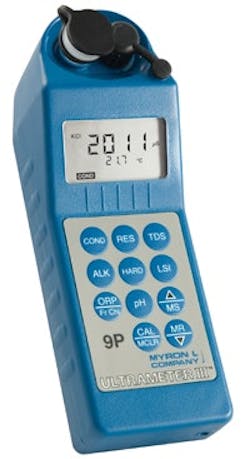In-Cell Titrations Make Real-Time Field Analysis Possible
The Ultrameter III 9P is based on the tried and tested design of the Ultrameter II 6P and measures conductivity, resistivity, TDS, pH, ORP, free chlorine and temperature quickly and accurately. The 9P also features new parameters that allow the user to perform titrations in the field. The Myron L Co. has developed a unique method of performing alkalinity, hardness and LSI titrations that makes field monitoring fast and feasible.
How does it work?
The 9P titrations are based on conductometric titration methods that are possible with the 9P’s advanced conductivity cell and microprocessor based design. Titrations are chemically equivalent to standard methods using colorimetric techniques, but replace color change identification of equivalence points with changes in conductivity, thereby replacing a subjective, qualitative assessment with a quantitative one. This means the instrument determines the equivalence point instead of the user and the method of analyzing the equivalence point is objective, rather than subjective.
What is a conductometric titration?
A conductometric titration is performed just like a colorimetric titration, only the equivalence point is determined by a change in conductivity rather than a change in color. This is based on the fact that changes in ionic concentration that occur as constituents react with reagents change the electrical conductivity of the solution.
A simple example can be given of the titration of a strong acid with a strong base. The acid solution, before the addition of the base, has a very high conductance owing to the concentration and mobility of the small hydrogen ions.
With the addition of the base, the hydroxide reacts with the hydrogen to form water, thus reducing the hydrogen ion concentration and effectively lowering the conductivity of the solution. The conductivity continues to decrease until all the hydrogen ions are consumed in the reaction, but then sharply increases with the next addition of base, which contains highly conductive hydroxide ions. The solution conductivity then continues to increase with each base addition. The equivalence point in this example would be a clearly defined minimum point of lowest conductivity (see Figure 2).
Not all solutions will give a plot with an equivalence point that is as easy to distinguish as the sharp upturn found in a strong acid-base titration, however. The 9P plots several reagent additions beyond any changes in conductivity and matches the derived curve to the behavior of solutions of known concentration.
Is a conductometric titration a standard method?
(Standard method comparison to methods listed in the Standard Methods for the Examination of Water and Wastewater published by the American Public Health Assn., the American WaterWorks Assn. and the Water Environment Assn.)
Myron L Co.’s conductometric titration methods are chemically equivalent to standard methods that use the same procedure, but with pH indicators. That means that they use the same reagents in the same sequence with the same theoretical approach. The difference lies in the 9P’s ability to determine the equivalence point based on numerical data, rather than subjective observation of a color change.
The alkalinity titration is modeled after standard method 2320. The sample is titrated with sulfuric acid and conductivity changes are recorded at each titration point.
The hardness titration is modeled after standard method 2340. To reduce the affects of high alkalinity in the form of bicarbonate, acid is first added to the sample. This shifts the bicarbonate toward carbonic acid, then carbon dioxide (reference the carbonic acid equilibrium), which is gassed off the sample. The sample is buffered above pH 10 (effectively pH 12) by the addition of sodium hydroxide. EDTA reagent is then added incrementally, with conductivity measured after each addition.
The LSI titration uses a simplified version of the thermodynamic equations for the determination of the scaling tendency of water developed in 1936 by Dr. Wilfred Langelier. The user simply titrates for alkalinity and hardness, then measures pH and temperature, and the 9P generates the saturation index value automatically.
Conductometric vs. Colorimetric
The benefits of determining the equivalence points by conductometric titrations are that the user does not have to interpret any results. The 9P does it for you using objective measurements. And the 9P is a faster method. For example, a typical colorimetric titration for hardness can take up to 30 drops of reagent, while the 9P method for the same concentration only requires six to eight drops. Colorimetric distinctions are sometimes hard to make, as well, especially when adding reagents drop by drop while trying to carefully observe the precise point at which the color changes—and that can lead to inaccurate data (see Figure 3). This is especially true in colored or turbid solutions.
The conductometric method can also be used with very dilute solutions or for solutions for which there is no suitable indicator. The conductometric titration method gives you empirical results that are calculated for you, eliminating potential sources of error. And the measurements can be stored in memory for later data transfer using the optional U2CI software and bluDock Bluetooth hardware installed on the 9P (see Figure 4). This makes data analysis and reporting seamless.
What else can the Ultrameter III do?
Alkalinity, hardness, pH and temperature values used to compute the saturation index of a sample can be manipulated in the LSI Calculator function, allowing you to perform on the spot analysis of water balance scenarios. You can use historical or theoretical data to populate the required values in the calculator.
And the 9P titration kit comes with all required accessories, reagents, and calibration solutions (see Figure 6). Call Myron L Company today to see how the 9P can streamline your field testing.
